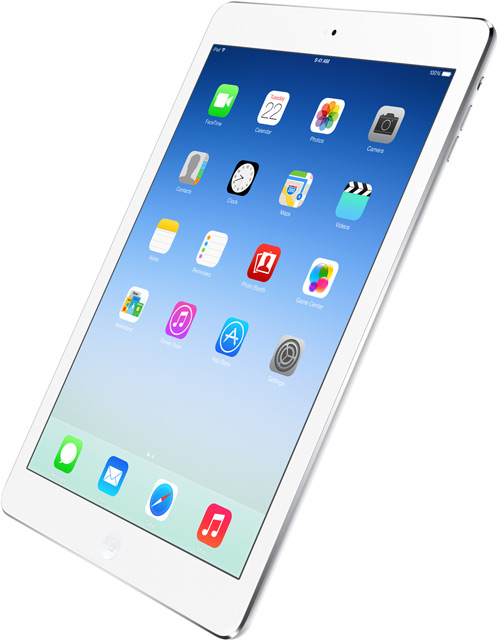|
 When Apple announce a new version of it's iconic tablet, the world goes crazy and millions are sold. This week the new super light and thin iPad Air hit the streets and it's a heck of a beautiful machine. When Apple announce a new version of it's iconic tablet, the world goes crazy and millions are sold. This week the new super light and thin iPad Air hit the streets and it's a heck of a beautiful machine.
But as a cricketer or coach, is the new iPad Air useful or just an expensive fashion item that is a sexy way to watch Netflix in bed?
Here are 7 useful things you can do with an iPad that will help you reach your goals.
1. Remember everything
The iPad is a joy to use for finding and reading information. Touching it is instinctive and easy for even the biggest luddite. The advantage here is that you can carry all your coaching manuals, eBooks, and drills in a 1lb slate.
Use the kindle app for the eBooks and Evernote for the drills and you have everything to hand for whatever type of practice you need. As the Evernote advertising says: Remember everything.
2. Notes and journals for training effectiveness
Admittedly, writing is less of a joy on the iPad than sitting in front of a keyboard or writing in a notebook. However, for note-taking on the fly, it's hard to beat because you can capture quickly and store the notes.
I strongly recommend that you keep personal notes and journals to assist your development. The act of writing down your thoughts and feelings about a game or session is useful in itself, but it also allows you to refer back and more objectively analyse how types of training effect your emotional state.
3. Peaceful, uncluttered mind
I often discuss the need to have an uncluttered mind to be at your best. It's not a new idea but it is notoriously tough to achieve. However, the iPad is a great personal assistant in your quest for peace of mind.
Keeping your life under control is the first step. These days we all have a million different tasks and tons of projects to keep an eye on: Work, home and cricket related. You can't keep all that in your head so you need a system to track it all so you don't have to think about it. The iPad helps with this in a number of ways:
- Organising with the basics of projects and next actions in list managers like Omnifocus.
- Giving you reminders based on time or on location (remembering to buy toilet roll in the toilet roll aisle of the supermarket).
- Reviewing your progress and planning your next move.
The iPad touch interface makes it a joy to create a dashboard of your life and power through tasks that are relevant to where you are and what you have to hand. Read David Allen's Getting Things Done for an overview of the system the iPad can support (yes, it's on kindle).
4. Arrive on time
Here's a very personal reason for an iPad: I get lost all the time. My sense of direction is so bad I once got lost in the 100 yards between a train station and a hotel (with no turns). It's so bad that when my team go to away games at a new ground nobody wants to go with me because we always end up lost. Even when I'm not driving.
Since using a device with a GPS, I have not got lost yet (I'm touching wood).
As you can imagine, the travel planning and directions in a iPad are crucial for me to get anywhere on time. And, like me, you can use the tablet to plan a journey before you leave (I use trains a lot and it's handy to plan a route both on the train and to/from the station). You can also use it for directions when you are on the way.
The benefit is that you can get to places with plenty of time to prepare. You don't have to rush through warm ups for your games, you can feel more relaxed. It may even help you win more matches.
5. Better coaching through visuals
One of the joys of the iPad is it's HD "retina" screen: Great for watching movies of course, but also excellent for watching batting and bowling with instant feedback. Great if you are a coach wanting to make a point, or a player who wants to see what is happening.
Naturally, it's no match for PV/VIDEO because you can't capture balls discreetly from multiple angles and tie them to other stats like line, length and pace. However, for a quick and dirty way to look at technique on the fly, the iPad does a stand up job. Just be careful where you hold it.
6. Learn more ways to improve
iPads are about having fast access to information. The web is loaded with ways to get better, especially on PitchVision Academy. You can use apps to manage this content and review it in those strange periods of time we have like waiting in the dentists office or a rain break at your match.
Taking advantage of downtime to go through your Pocket list will reap the rewards of new ideas to with training, playing, eating, fitness and mental toughness. You just need to go do it (see number three).
7. Scratch the creative itch and talk to like-minded souls
So far we have talked about a lot of collecting and organising information. That is the strength of the iPad. But it also has a place in helping your creativity.
As you can imagine, this is appealing to me because I a lot to say as both a coach and player. If you have something to add (and these days, everyone does), you can:
- Write with Drafts
- Post to social media like Google+ and Twitter
- Record and edit videos or podcasts (if you are the talky type)
- Produce email newsletters (great if you are a coach)
I am really interested in this use for the iPad. So get in touch if you are a player or a coach and want to scratch that creative itch. We certainly have a place for you on PitchVision Academy.
However, the bottom line here is a simple one: The iPad is a highly portable computer. It's powerful to do anything you can do on a laptop but without the bulk. That means you can use it at home or work and you can take it with you to matches and training sessions and put it to work when you need it.
Will it make you a better player? No. Nothing will replace good old fashioned practice to do that, but it will help you be in control of what happens around your practice and games.
So use it right and - when combined with hard work - it will help you get the most from your talent. I would recommend it above most consumer laptops for most cricketers and coaches.
Discuss this article with other subscribers
|

.jpg)



.jpg)

